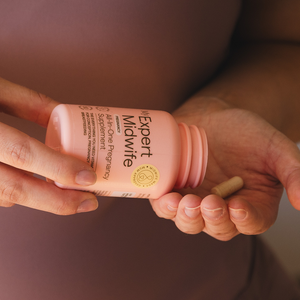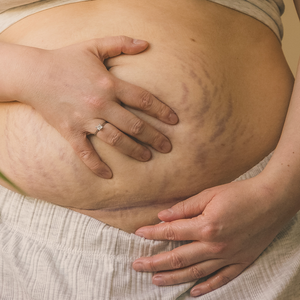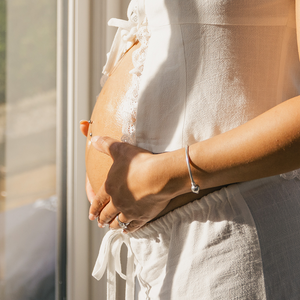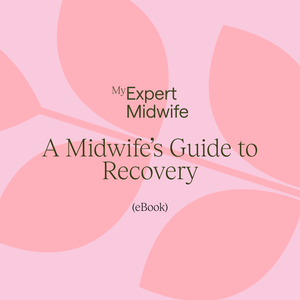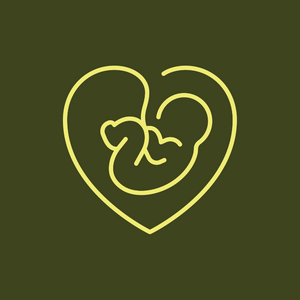Birthing the placenta
Before your baby is born or straight after the birth, your midwife will ask you how you would like to give birth to your placenta. The placenta (sometimes called the afterbirth) is the organ which has grown in pregnancy to nourish your baby in the womb and now also needs to be birthed. The time between the birth of your baby and the birth of your placenta is known as the third stage of labour.
There are two options when birthing the placenta: physiological and active management.
- Physiological management is when you birth the placenta yourself. The cord is left and not clamped, you are kept warm and comfortable with your baby skin-to-skin to enable your body to continue to produce oxytocin (the hormone needed to contract the uterus and birth the placenta) and, when ready, you push the placenta out. This can take anything up to about an hour and, sometimes, even a bit longer.
- Active management is when an injection of an oxytocic (synthetic oxytocin) drug is given into your thigh, the cord is clamped and cut, and the midwife gently eases the placenta out. This usually takes less time, maybe around 10 minutes or so.
What is a retained placenta?
For a few women, the placenta may not birth easily, and this is when a retained placenta is diagnosed. A retained placenta is when some or all of the placenta and membranes remains in the uterus (womb). It is recommended that a retained placenta is treated promptly to prevent potential complications, such as further bleeding, which could lead to a postpartum haemorrhage (PPH).
In hospital, a retained placenta is diagnosed if:
- your placenta has not delivered within one hour of your baby’s birth if you are having physiological management
- or within thirty minutes if you are having active management
If you chose to have a physiological third stage and your placenta is not born after an hour, your midwife will discuss giving you the injection of the drug (commonly, ergometrine or syntocinon in the UK) that can make your womb contract and help birth your placenta.
Your doctor and midwife will closely monitor your vital signs, your general wellbeing and how much you are bleeding whilst your placenta is still in your uterus. If you are stable and there is no evidence of heavy bleeding, you may choose to discuss allowing more time to see if your placenta is born without the need to remove it manually. Using the B.R.A.I.N. acronym can help you make decisions that are right for you.
Your midwife may encourage you do to a few other things to try and encourage the placenta to separate, such as:
- Help you to pass urine (you may be offered a catheter to empty your bladder)
- Encourage breastfeeding (this stimulates oxytocin, which helps the uterus to contract)
- Ask you to alter your position, perhaps to a squat or sitting on the toilet
If your placenta remains in the uterus, despite all attempts to help it to come out, a doctor will discuss your options for removing it manually.
What causes a retained placenta?
A retained placenta can be caused by:
- The uterus not contracting properly after the baby is born
- The umbilical cord snapping which is rare and will not hurt your baby if managed quickly - your midwife will simply clamp the cord to prevent bleeding
- The placenta being more deeply adhered into the wall of the uterus than normal
How is the placenta removed?
Before the decision is made to transfer you to theatre for a manual removal of placenta, a doctor will come in to meet you, assess how you are feeling and offer to do a vaginal examination in the room to check if the placenta is within easy reach (it may be high up in the vagina or the cervix) and can therefore be removed without the need to go into theatre. As this examination can be quite uncomfortable, you will be offered pain relief – make sure to communicate if this is too uncomfortable for you to tolerate, so you can be suitable topped-up.
Once the doctor has diagnosed a retained placenta, the procedure will be discussed with you to gain your consent. Unless this is an emergency (very unlikely), you will need to sign a written consent form.
A manual removal of placenta:
- Is considered an operation, but requires no scalpel or stitches (unless you have torn or had an episiotomy in labour, which will be repaired by the doctor after your placenta is delivered)
- Needs to be done under a spinal anaesthetic or a suitable top-up of your epidural, if you had one in labour, so that you are numb from the waist down
- Requires you to have an empty bladder, for which you will need a urinary catheter to drain your bladder during the procedure and for a few hours after
- Requires you to have intravenous access (a cannula) for fluids and drugs – you may already have this from labour or it may be sited whilst your are in the room, birth centre or at home
- Needs for your legs to be in the lithotomy position
- Involves the doctor placing their fingers inside the uterus to detach the placenta and remove it, while their other hand is placed firmly on your tummy to stabilise the top of the uterus
- Should be completely pain-free, but you may feel some odd pulling sensations
- Needs to be done in a consultant-led unit, so if you are at home or in a midwifery-led unit, you and your baby (and your birth partner) will be transferred via ambulance – your midwife will arrange this, keep you comfortable and warm during transfer, and accompany your throughout the whole process
How common is a retained placenta?
Approximately 3% of vaginal births involve a retained placenta and it can occasionally happen after a caesarean section.
Who is more at risk of having a retained placenta?
Your chances of having a retained placenta are increased if:
- You have a long first and second stage of labour
- Your baby is born prematurely
- You have previously had a retained placenta
- You have had previous surgery to your uterus
- You have birthed 5 or more babies prior to this pregnancy
- Your uterus has a congenital anomaly
- You are over the age of the 30
- Your baby is stillborn
Are there any risks for a manual removal of placenta?
A manual removal of placenta is usually a straightforward and safe procedure. However, as with everything, there are some risks involved which your doctor will discuss with you before the operation. These include:
- Excessive blood loss or postpartum haemorrhage (PPH) – although this is also a risk whilst the placenta is retained
- Small portions of placenta or membranes being left in the uterus – potentially causing heavy bleeding up to 2 weeks after delivery and/or infection (known as endometritis). It is important to note that this can happen whether your placenta is birthed naturally or manually removed
- Infection – for which you may be prescribed antibiotics. Infection is also a risk if the placenta is retained and not removed
- Cramps and discomfort following the operation. You will be prescribed regular pain-killers.
What if I have had a previous retained placenta, will it happen next time?
Your chances of having a retained placenta do increase slightly if you have had one before, but this does not mean it will definitely happen. Your midwife will discuss your options for birthing your placenta during your pregnancy and when you go into labour.
Recovery after a retained placenta
It is normal to have some discomfort, cramping and bleeding after birth and, after a manual removal of placenta, you may find that you experience more discomfort and abdominal cramps, which is why you will be encouraged to keep topped up with regular pain-relief. The team looking after you will keep a close eye on your bleeding whilst you are in hospital and will advise you on what is normal postpartum bleeding and when to contact your maternity assessment centre.
If you experience any of the below, contact your maternity assessment centre or delivery suite for advice:
- A high temperature
- Offensive smell from your vagina
- Large blood clots or pieces of tissue coming out of your vagina
- Heavy bleeding that soaks your maternity pads that does not seem to be settling
- Pain that is not relieved with simple pain killers
Summary
A retained placenta can happen regardless of how you have chosen to manage your third stage of labour, although your chances of retaining your placenta may be increased depending on your medical and obstetric history. A manual removal of placenta is done by a doctor, in theatre and under regional anaesthetic and it is usually a safe and straightforward procedure, with a low risk of complications, and from which most women recover well.
